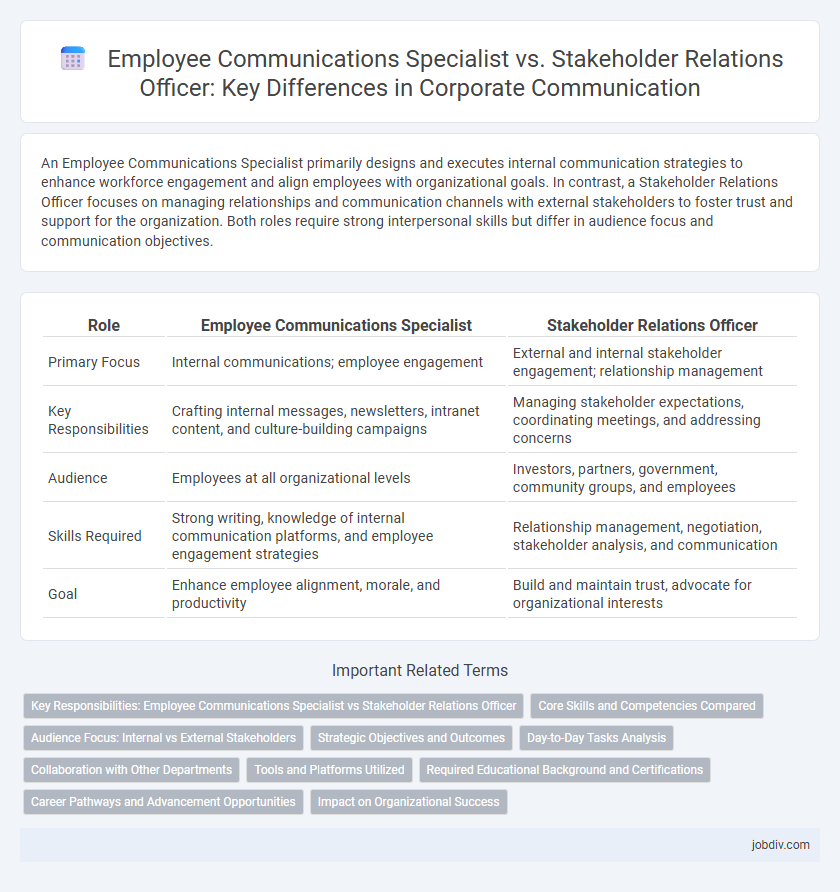An Employee Communications Specialist primarily designs and executes internal communication strategies to enhance workforce engagement and align employees with organizational goals. In contrast, a Stakeholder Relations Officer focuses on managing relationships and communication channels with external stakeholders to foster trust and support for the organization. Both roles require strong interpersonal skills but differ in audience focus and communication objectives.
Table of Comparison
| Role | Employee Communications Specialist | Stakeholder Relations Officer |
|---|---|---|
| Primary Focus | Internal communications; employee engagement | External and internal stakeholder engagement; relationship management |
| Key Responsibilities | Crafting internal messages, newsletters, intranet content, and culture-building campaigns | Managing stakeholder expectations, coordinating meetings, and addressing concerns |
| Audience | Employees at all organizational levels | Investors, partners, government, community groups, and employees |
| Skills Required | Strong writing, knowledge of internal communication platforms, and employee engagement strategies | Relationship management, negotiation, stakeholder analysis, and communication |
| Goal | Enhance employee alignment, morale, and productivity | Build and maintain trust, advocate for organizational interests |
Key Responsibilities: Employee Communications Specialist vs Stakeholder Relations Officer
Employee Communications Specialists focus on crafting internal messaging, managing corporate newsletters, and coordinating employee engagement initiatives to enhance workforce alignment and morale. Stakeholder Relations Officers prioritize building and maintaining relationships with external partners, investors, and community members, ensuring transparent communication and addressing stakeholder concerns. Both roles require strategic communication skills, but the former targets internal audiences while the latter manages external stakeholder engagement.
Core Skills and Competencies Compared
Employee Communications Specialists excel in internal messaging, mastering skills such as content creation, employee engagement, and intranet management to foster transparent organizational culture. Stakeholder Relations Officers specialize in external communication, demonstrating competencies in stakeholder analysis, relationship management, and strategic communication to enhance corporate reputation. Both roles require strong interpersonal, writing, and analytical abilities, but differ in audience focus and strategic impact within communication frameworks.
Audience Focus: Internal vs External Stakeholders
An Employee Communications Specialist primarily targets internal stakeholders such as employees and management, crafting messages that enhance engagement and align organizational culture. In contrast, a Stakeholder Relations Officer focuses on external stakeholders including investors, partners, and the community, managing communications to build trust and foster positive external relationships. Understanding these distinct audience focuses ensures tailored communication strategies that meet specific stakeholder needs and organizational goals.
Strategic Objectives and Outcomes
An Employee Communications Specialist focuses on aligning internal messaging with organizational culture to enhance employee engagement and drive productivity, directly supporting strategic objectives related to workforce cohesion and morale. In contrast, a Stakeholder Relations Officer prioritizes managing relationships with external and internal stakeholders, ensuring transparent communication that advances corporate reputation and partnership-building outcomes. Both roles contribute to strategic goals but differ in target audiences and key performance indicators, with the former centered on internal alignment and the latter on external influence and trust.
Day-to-Day Tasks Analysis
An Employee Communications Specialist focuses on crafting internal messages, managing intranet content, and coordinating employee engagement initiatives to enhance organizational culture and information flow. In contrast, a Stakeholder Relations Officer handles communication strategies targeted at external parties such as investors, partners, and regulatory bodies, ensuring alignment with corporate goals and maintaining positive relationships. Daily duties for the former emphasize internal dialogue management, while the latter prioritizes external messaging and stakeholder engagement analysis.
Collaboration with Other Departments
Employee Communications Specialists coordinate closely with human resources, marketing, and leadership teams to ensure consistent messaging and enhance employee engagement across all departments. Stakeholder Relations Officers collaborate primarily with external affairs, corporate communications, and legal departments to manage stakeholder expectations and align organizational goals with external interests. Both roles require cross-departmental collaboration to foster transparent communication and maintain organizational coherence.
Tools and Platforms Utilized
Employee Communications Specialists primarily use internal communication platforms such as intranets, email newsletters, collaboration tools like Microsoft Teams, and employee engagement software to ensure clear and consistent messaging within an organization. Stakeholder Relations Officers leverage broader communication tools including customer relationship management (CRM) systems, social media platforms, press release distribution services, and stakeholder mapping software to manage external relationships effectively. Both roles rely on analytics tools to measure engagement and tailor communications, but the specialist focuses on internal alignment while the officer targets external stakeholder engagement.
Required Educational Background and Certifications
An Employee Communications Specialist typically requires a bachelor's degree in communications, public relations, or a related field, with certifications such as the Certified Communication Professional (CCP) enhancing credibility. In contrast, a Stakeholder Relations Officer often holds degrees in business, public relations, or social sciences, complemented by certifications like the Project Management Professional (PMP) or Chartered Institute of Public Relations (CIPR) accreditation. Both roles emphasize strong communication skills, but stakeholder relations demand broader expertise in project and relationship management.
Career Pathways and Advancement Opportunities
Employee Communications Specialists typically advance by developing expertise in internal messaging, moving into roles such as Internal Communications Manager or Corporate Communications Director. Stakeholder Relations Officers often progress by expanding their network and strategic influence, leading to positions like Public Affairs Manager or Director of Stakeholder Engagement. Both career paths offer opportunities to enhance leadership skills and impact organizational reputation through effective communication strategies.
Impact on Organizational Success
Employee Communications Specialists enhance organizational success by crafting clear, targeted messages that boost employee engagement and alignment with company goals, fostering a cohesive work environment. Stakeholder Relations Officers contribute by managing relationships with external partners, investors, and community members, ensuring positive perception and support crucial for strategic initiatives. Both roles drive organizational success through effective communication, but the Employee Communications Specialist focuses on internal culture and engagement, while the Stakeholder Relations Officer emphasizes external reputation and alliance-building.
Employee Communications Specialist vs Stakeholder Relations Officer Infographic

 jobdiv.com
jobdiv.com